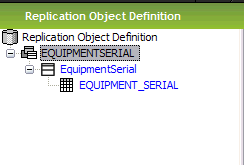

This window includes the complete Replication Object information.
The Master Lu in each Replication Object is colored blue.
When the form is populated the definition in the replication repository is compared with the Oracle data dictionary. If a logical unit is colored red, the definition in the replication repository is not consistent with the data dictionary description of the object. A RMB function can be used to refresh the replication repository.
For the description of different forms that displays in the right hand side of this window follow the appropriate link: Select the logical unit's context, View Column Information.
The operations available in this window are dependent on what is currently selected in the navigator.
|
Operations |
Description |
|---|---|
| Insert Replication Object Definition | The function works in the same way as the form Replication Object Definition - Overview. |
|
Operations |
Description |
|---|---|
| Remove Replication Object Definition | removes the selected Replication Object Definition from the replication repository. |
| Insert LU | inserts a new LU into the selected Replication Object Definition. A dialog box is opened where you enter Component, LU Name and Context. |
When a logical unit is selected a RMB contains the operations and , , The function Remove LU r. The function Refresh LU
|
Operations |
Description |
|---|---|
| Remove LU | removes the selected logical unit from the Replication Object Definition. |
| Refresh LU | updates the replication repository with the missing information for the logical unit. This is available if the logical unit is colored red, meaning that the definition and the actual interface of the LU does not match. |
No actual fields are defined in this form. The contents of the right hand part of the form change layout depending on what navigator object is selected. Follow the links to the associated forms: